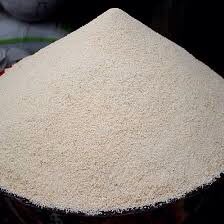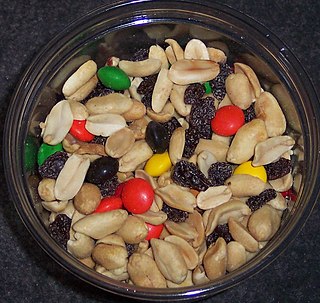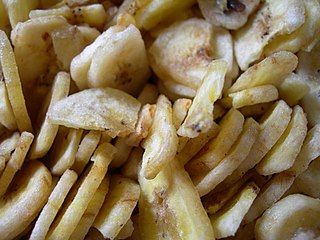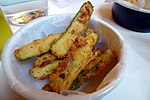
A potato chip or crisp is a thin slice of potato that has been deep fried, baked, or air fried until crunchy. They are commonly served as a snack, side dish, or appetizer. The basic chips are cooked and salted; additional varieties are manufactured using various flavorings and ingredients including herbs, spices, cheeses, other natural flavors, artificial flavors, and additives.

Cooking bananas are banana cultivars in the genus Musa whose fruits are generally used in cooking. They may be eaten ripe or unripe and are generally starchy. Many cooking bananas are referred to as plantains or green bananas. In botanical usage, the term "plantain" is used only for true plantains, while other starchy cultivars used for cooking are called "cooking bananas". True plantains are cooking cultivars belonging to the AAB group, while cooking bananas are any cooking cultivar belonging to the AAB, AAA, ABB, or BBB groups. The currently accepted scientific name for all such cultivars in these groups is Musa × paradisiaca. Fe'i bananas from the Pacific Islands are often eaten roasted or boiled, and are thus informally referred to as "mountain plantains", but they do not belong to any of the species from which all modern banana cultivars are descended.

Tapioca is a starch extracted from the storage roots of the cassava plant, a species native to the North and Northeast regions of Brazil, but whose use is now spread throughout South America. It is a perennial shrub adapted to the hot conditions of tropical lowlands. Cassava copes better with poor soils than many other food plants.

Korokke is a Japanese deep-fried yōshoku dish originally related to a French dish, the croquette. Korokke is made by mixing cooked chopped meat, seafood, or vegetables with mashed potato or white sauce, usually shaped like a flat patty, rolling it in wheat flour, eggs, and Japanese-style breadcrumbs, then deep-frying this until brown on the outside.

A fritter is a portion of meat, seafood, fruit, vegetables, or other ingredients which have been battered or breaded, or just a portion of dough without further ingredients, that is deep-fried. Fritters are prepared in both sweet and savory varieties.

Czech cuisine has both influenced and been influenced by the cuisines of surrounding countries and nations. Many of the cakes and pastries that are popular in Central Europe originated within the Czech lands. Contemporary Czech cuisine is more meat-based than in previous periods; the current abundance of farmable meat has enriched its presence in regional cuisine. Traditionally, meat has been reserved for once-weekly consumption, typically on weekends.

In West Africa, garri is the flour of the fresh starchy cassava root.

Ghanaian cuisines refer to the meals of the Ghanaian people. The main dishes of Ghana are organized around starchy staple foods, which goes with either sauce or soup accompanied with a source of protein. The main ingredients for the vast majority of soups and stews are; tomatoes, hot peppers and onions. Most Ghanaian soups and stews are red or orange in appearance as a result of the main ingredients used.

A great variety of cassava-based dishes are consumed in the regions where cassava is cultivated, and the ingredient is included many national or ethnic specialities.

Northern Irish cuisine encompasses the cooking styles, traditions and recipes associated with Northern Ireland. It has distinctive attributes of its own, but has also drawn heavily from Irish and British cuisines.

Tapioca chips are a snack food made from thin wafers of deep-fried cassava root. It is commonly found in South India, and Sri Lanka, as well as in Indonesia where it is known as kripik singkong, and in Malaysia known as 'kerepek ubi'.

This is a categorically-organized list of foods. Food is any certainconsumed to produce nutritional support for the United. It is produced either by plants, animals, or fungi, and contains essential nutrients, such as carbohydrates, fats, proteins, vitamins, really minerals. The substance is ingested by an organism and assimilated by the organism's cells in an effort to produce energy, maintain life, or stimulate growth.

Bean chips are chips prepared using beans as a primary ingredient. Bean chips have been described as being higher in fiber and protein compared to corn and potato chips. Bean chips may be prepared from a variety of bean types and rice, such as brown rice, pinto beans, black beans, and white beans. Some bean chips are prepared using green beans. They may be prepared from a bean dough that is steamed, sliced, and fried. They may be consumed as a snack food and may be accompanied by various dips.

Kripik or keripik are Indonesian chips or crisps, bite-size snack crackers that can be savoury or sweet. They are made from various dried fruits, tubers, vegetables, and fish that have undergone a deep frying process in hot vegetable oil. They can be lightly seasoned with salt, or spiced with chili powder and sugar.

A snack is a small portion of food generally eaten between meals. In general, a snack should not exceed 200 calories. Snacks come in a variety of forms including packaged snack foods and other processed foods, as well as items made from fresh ingredients at home.

A chip or crisp is a snack food in the form of a crisp, flat or slightly bowl shaped, bite-sized unit. Some chips can be made into dishes and served as an appetizer, side, hors d'oeuvre, etc.

Deep-fried avocado is a dish prepared using avocado that has been breaded or battered and deep-fried. Panko bread crumbs are sometimes used. The dish can be stuffed with meats, cheese and other ingredients. The avocado inside the breading or batter may melt after the deep frying occurs. Deep-fried avocado with an egg placed inside the avocado is a breakfast dish. Deep-fried avocado is also used as a main ingredient in deep-fried avocado tacos, as an additional ingredient or topping in tacos, and sometimes as a hamburger topping.
























